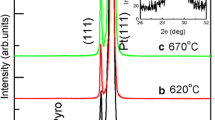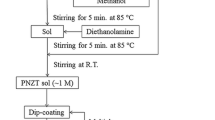Abstract
Deposition of thin films via hydrothermal method has various advantages: low deposition temperature, high purity, deposition on a three-dimensional structure,and a large thickness. Although an epitaxial lead zirconate titanate (PZT) thin-film deposition has been reported, the ferroelectric measurement has not been conducted due to the peel-off morphology of the film. The current paper investigates the improvement of an epitaxial PZT thin film deposited via a hydrothermal method. By adjusting the position at which the substrate was suspended in the solution, smooth morphology surface was successfully obtained. As a bottom electrode, a 200-nm SrRuO3 thin film was deposited on SrTiO3 single crystals, and the PZT thin film was deposited on SrRuO3. The remanent polarization 2Pr and coercive electric field for PZT on SrRuO3/SrTiO3 (001) were 17.1 μC/cm2 and 36 kV/cm, respectively, and those of PZT on SrRuO3/SrTiO3 (111) were 32.7 μC/cm2 and 59 kV/cm, respectively. The reason for large imprint electrical field, 91 kV/cm and 40 kV/cm for each film, was unclear at this stage, although it is associated with self–alignment poling direction. This self–alignment poling direction was confirmed via scanning nonlinear dielectric microscopy and is thought to have been related to the deposition mechanisms.
Similar content being viewed by others
References
T. Morita: Miniature piezoelectric motor. Sens. Actuators 103, 291 (2003).
N. Ledermann, P. Muralt, J. Baborowski, S. Gentil, K. Mukati, M. Cantoni, A. Seifert, and N. Setter: {100}-Textured, piezoelectric Pb(Zrx, Ti1-x)O3 thin films for MEMS: Integration, deposition and properties. Sens. Actuators, A 105, 162 (2003).
C. Guerrero, J. Roldan, C. Ferrater, M.V. Garcia-Cuenca, F. Sanchez, and M. Varela: Growth and characterization of epitaxial ferroelectric PbZrxTi1-xO3 thin film capacitors with SrRuO3 electrodes for non-volatile memory applications. Solid-State Electron. 45, 1433 (2001).
J.H. Kim, Y. Kim, A.T. Chien, and F.F. Lange: Epitaxial growth of PbZr0 5Ti0 5O3 thin films on SrRuO3/SrTiO3 substrates using chemical solution deposition: Microstructural and ferroelectric properties. J. Mater. Res. 16, 1739 (2001).
T. Oikawa T, M. Aratani, K. Saito, and H. Funakubo: Composition dependence of ferroelectric properties of epitaxial Pb(ZrxTi1-x)O3 thin films grown by metalorganic chemical vapor deposition. J. Cryst. Growth 237, 455 (2002).
I. Kanno, H. Kotera, K. Wasa, T. Matsunaga, T. Kamada, and R. Takayama: Crystallographic characterization of epitaxial Pb(ZrxTi1_x)O-3 films with different Zr/Ti ratio grown by radio-frequency-magnetron sputtering. J. Appl. Phys. 93, 4091 (2003).
K. Shimomura, T. Tsurumi, Y. Ohba, and M. Daimon: Preparation of lead zirconate titanate thin-film by hydrothermal method. Jpn. J. Appl. Phys. 30, 2174 (1991).
T. Morita, T. Kanda, Y. Yamagata, M.K. Kurosawa, and T. Higuchi: Single process to deposit PZT thin film by hydrothermal method. Jpn. J. Appl. Phys. 36, 2998 (1997).
T. Morita, M.K. Kurosawa, and T. Higuchi: Cylindrical micro ultrasonic motor using PZT thin film deposited by single process hydrothermal method (ϕ 2.4mm, L10mm Stator Transducer). IEEE Trans. Ultrasonic, Ferroelectrics, and Frequency Control 45, 1178 (1998).
T. Morita, M.K. Kurosawa, and T. Higuchi: A cylindrical shaped micro ultrasonic motor utilizing PZT thin film. Sens. Actuators 83, 225 (2000).
T. Kanda, T. Morita, M.K. Kurosawa, and T. Higuchi: Estimation of resolution and contact force of a longitudinally vibrating touch probe sensor using PZT thin-film vibrator. Jpn. J. Appl Phys 40, 3646 (2001).
A.T. Chien, J.S. Speck, and F.F. Lange: Hydrothermal synthesis of heteroepitaxial Pb(ZrxTi1-x)O3 thin film at 90-150. J. Mater. Res. 12, 1176 (1997).
M. Oledzka, M.M. Lencka, P. Pinceloup, K. Mikulka-Bolen, L.E., McCandlish, and R.E. Riman: Influence of precursor on micro-structure and phase composition of epitaxial hydrothermal PbZr07Ti03O3 films. Chem. Mater. 15, 1090 (2003).
K. Takahashi, T. Oikawa, K. Saito, S. Kaneko, H, Fujisawa, M. Shimizu, and H. Funakubo: Effect of strain in epitaxially grown SrRuO3 thin films on crystal structure and electric properties. Jpn. J. Appl. Phys. 41, 5376 (2002).
Y. Cho, S. Kazuta, and K. Matsuura: Scanning nonlinear dielectric microscopy with nanometer resolution. Appl. Phys. Lett. 75, 2833 (1999).
C. Guerrero, J. Roldan, C. Ferrater, M.V. Garcia-Cuenca, F. Sanchez, and M. Varela: Growth and characterization of epitaxial ferroelectric PbZrxTi1-xO3 thin film capacitors with SrRuO3 electrodes for non-volatile memory applications. Solid-State Electronics 45, 1433 (2001).
Author information
Authors and Affiliations
Corresponding author
Rights and permissions
About this article
Cite this article
Morita, T., Wagatsuma, Y., Morioka, H. et al. Ferroelectric property of an epitaxial lead zirconate titanate thin film deposited by a hydrothermal method. Journal of Materials Research 19, 1862–1868 (2004). https://doi.org/10.1557/JMR.2004.0243
Received:
Accepted:
Published:
Issue Date:
DOI: https://doi.org/10.1557/JMR.2004.0243




